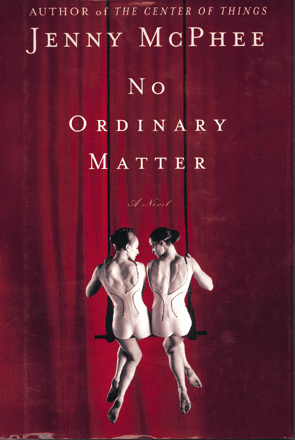Neurodrama
- Christie Carrico, PhD
No Ordinary Matter Jenny McPhee. New York: Free Press; 2004. 272 pages. $23.00 ISBN: 0743260724

The opening scene of this book is reminiscent of an episode of Frasier in which that title character, settled into a familiar Seattle coffee shop, awaits the arrival of his brother Niles. In No Ordinary Matter, we first encounter Veronica, awaiting the arrival of her sister Lillian, at the Hungarian Pastry Shop, where the two women meet the first Monday of every month. Veronica is a scriptwriter for TV’s most popular soap opera, Ordinary Matters. Lillian, on the other hand, has an MD/PhD in neuroscience from Columbia, with a medical specialization in rehabilitation following head injury. She works in the laboratory of an oddball scientist who has a crush on her, and she publishes prolifically, in wildly unrelated areas of neuroscience, supplementing her income by consulting for soap operas and insurance companies. Lillian is considered variously, sometimes as a genius ahead of her time, and sometimes as a scientific gadfly not serious enough about any single area of research. She works on achromatopsia (discussed in Oliver Sachs’s book Island of the Color Blind), as well as on the biology of smell and an anxiety disorder called Selective Mutism, just to name a few of her pursuits. But one thing that everyone, including her sister, agrees on is that Lillian is both unconventional and stunningly beautiful. Lillian is the alpha character of the book—she is, after all, a neuroscientist!—while Veronica tends to take the backseat role. As the plainer, younger sister, Veronica has indeed lived much of her life in Lillian’s shadow.

The plot of the book is as eccentric as the characters are; it leaps around in time and space, settling first on episodes of Veronica and Lillian’s childhood, then moving to the present, and finally bringing us to events in the recent past. While this timeline is necessary because the one main thread running through the book is the girls’ desire to find out more about their father, who died in a car crash when they were children, it is sometimes disconcerting. The narrative has more twists than a pretzel. But if the plot moves forward in fits and starts, the ride that it imparts to the reader is ultimately one of the things that make this book fun to read.
The other thing that makes this book fun to read is the collection of colorful characters. In addition to the two sisters, there is Bryan Byrd, the private investigator they hire to look into their father’s past. Bryan Byrd resembles a blond Orson Welles, wears outlandishly out-of-style suits, and has something of a superiority complex. In addition to being a private investigator, he is a jazz tuba player as well as a dabbler in the neurosciences. That is to say, he belongs to the Society for Neuroscience and attends their annual meeting, portraying himself as a neuroscientist.
Then there is Jane Lust, the fifty-something producer of Ordinary Matters, who flaunts a bouffant hairstyle that only Dolly Parton could envy and a wardrobe designed to match both shoes and eye shadow. And finally, Alex Drake, the out-of-work actor who has a one-night stand with the conniving Lillian, herself intent on conceiving a child, by means of a doctored condom, and not having to worry about a father. Alex subsequently lands a role as both doctor (a neurosurgeon, no less) and love-interest in Ordinary Matters. On the set of his new acting job, Alex meets and begins an affair with Veronica.
In the background of the novel, it is really the mysterious figures of Veronica and Lillian’s mother and father who drive the plot. Their marriage had apparently not been a very happy one. The mother is a nurse, somewhat cold and unlovable, who moved to New Zealand to raise sheep as soon as the girls went off to college. She calls them twice a year, but wants nothing else to do with them and is certainly not someone they can ask about their past. The father may have been having an affair and may have been en route, with Lillian, to see his mistress when he was killed in the car crash. The mystery surrounding these events also suggests the existence of a half-brother. Oh, by the way, Alex Drake is an orphan. He was put up for adoption by someone with the same name as Lillian and Veronica’s mother. To recap: Veronica is in love and having an affair with a man who is likely to be her half-brother Alex, and who has impregnated her sister (also his half-sister) Lillian. See what I mean about the plot?
There are lots more characters, subplots, and plot twists, but they are best encountered by reading the book. Suffice it to say that in the end Lillian and Veronica find answers about their past, although not, perhaps, the ones they were seeking.
No Ordinary Matter is funny in a perverse way. A great book to read on an airplane or at the beach, it is easy to lose oneself in the characters and the plot. It is not a book to be taken seriously, although the random occasional passages describing neuroscientific phenomena are accurate enough.
Jenny McPhee is an eclectic author. She has written one other novel, The Center of Things, and has translated a book by Pope John Paul II. She writes both short fiction and nonfiction for The New York Times and is on the board of the Bronx Academy of Letters (who knew?).
- © American Society for Pharmacology and Experimental Theraputics 2005

Christie Carrico, PhD, is Executive Officer for ASPET.



